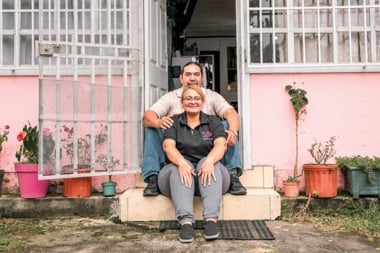Animal Testing

Perhaps you have seen the images of fluffy white rabbits, locked into restraining devices while substances are smeared into their eyes or rubbed onto their shaved skin to test for a reaction. Animal testing to determine the safety of cosmetics, personal care products, and household cleansers is only part of the science that involves warm-blooded mammals.
Perhaps you have seen the images of fluffy white rabbits, locked into restraining devices while substances are smeared into their eyes or rubbed onto their shaved skin to test for a reaction. Animal testing to determine the safety of cosmetics, personal care products, and household cleansers is only part of the science that involves warm-blooded mammals.
Animals are also used, and subsequently killed, every year in many other types of laboratory experiments, from military testing to simulated car crashes to deliberately introduced diseases such as AIDS and Alzheimer’s. These experiments take place in labs at universities, pharmaceutical companies, and testing agencies, and on farms and military bases around the world.
A Noah’s Ark of Victims
While it is estimated that rodents, including the typical mouse and rat, account for as many as 90 percent of all laboratory animals, a variety of animals are used in laboratory experiments, including gerbils, hamsters, guinea pigs, rabbits, dogs, cats, and primates such as monkeys, baboons, chimpanzees, gorillas, and orangutans.
How many animals are used? Statistics are hard to come by, especially since the US revised its Animal Welfare Act in 2002 to specifically exempt mice and rats from statistical counts. The British Union for the Abolition of Vivisection estimates that 10 to 11 million animals are experimented on every year in the UK. In 2002 the US Department of Agriculture used 1,137,718 animals (remember, this number does not include mice or rats). In 1999 more than 1.7 million animals were subjected to testing in Canada.
Animals are Economical–and Dispensable
Why are animals used? Researchers who conduct experiments on animals argue that it would be unethical to test substances with potentially adverse side effects on humans; animals are good surrogates because their responses are similar to humans. However, some animals are chosen for other reasons. Rodents are used for reasons of space, economy, and convenience as they are smaller than larger test animals, such as dogs and monkeys, and can therefore be housed by the hundreds in less space. Rodents also reproduce quickly, making them economical and dispensable.
Many scientists support animal research because their careers depend upon it. Studies using animals produce faster results with less effort since animals have a shorter life span than humans, allowing an animal researcher to publish more papers than one who studies humans. The more articles they publish, the more prestige and job security they can attain.
A Life of Isolation, Boredom, and Pain
Although scientists who experiment on animals claim the test subjects are treated humanely, the fact is that research animals never live the way nature intended. Naturally social animals, such as chimpanzees, who in the wild would live in groups, groom one another, and play together, are housed one by one in small cages. Other animals such as mice and rats are crammed by the hundreds into tiny cages.
A large number of lab animals suffer isolation, boredom, anxiety, psychological distress, separation from their mothers soon after birth, and sleeplessness. These discomforts are in addition to the physical pain the animals endure during performance of the experiments.
Animal-Free Alternatives
Animal testing is not the only option in toxicity testing. Alternatives are widely available and include human clinical and epidemiological studies; experiments with cadavers, volunteers, and patients; computer simulation and mathematical models; and in vitro (test tube) tissue culture techniques, to name just a few. Reconstructed human skin models such as EpiDerm and EPISKIN can replace skin corrosion tests on rabbits.
Life After the Lab…If You’re Lucky
Most research animals will never see the outside of a lab. In fact, most animals used in research are purpose-bred in labs. Many animals are killed off as surplus or are euthanized when they are no longer deemed “useful.” Yet others die during research from side effects of the research itself. Take, for example, the lethal dose, 50 percent (LD50) test. In this experiment, a group of animals are force-fed increasing quantities of a substance until 50 percent of them die.
A very small percentage of lab animals, once they’ve outlived their “usefulness” or are rescued from labs, are lucky enough to live out the rest of their lives in sanctuaries such as the one founded by Quebec’s Fauna Foundation. (For more information on the Fauna Foundation’s animal sanctuary, see “Gentle Giants” in alive’s March 2006 issue.) In these animal sanctuaries, animals live the way nature intended, with fresh water and food, sunshine, the companionship of other animals, and room to move around. Unfortunately, few facilities exist for rescued and “useless” research animals.
Cut Out Cruelty
You can help prevent the cruel and unnecessary use of animals in laboratory research by doing the following:
- Boycott charities that support and fund the use of animals in research. A list of charities that do and do not support animal research is available through the website of People for the Ethical Treatment of Animals, or PETA (peta.org), or visit HumaneSeal.org.
- Write to the Canadian Institutes of Health Research (cihr.ca) and the US National Institutes of Health (nih.org), the major sources of funding for animal-based research in North America, and tell them you don’t want your tax dollars used to fund experiments using animals.
- If you are a student or the parent of a student, object to school biology lessons that involve animal dissection. As more students and parents object, teachers and administrators will be compelled to respond by providing alternative study methods such as three-dimensional models and videotapes.
- Live by example. When you purchase cruelty-free personal and household products, refuse to dissect an animal, write a letter to the government on behalf of animals, or wear a T-shirt with an antivivisection slogan, you set an example. In other words, you walk the talk.
- For even more tips on how you can help prevent cruelty to animals, download the highly informative booklet, 42 Ways to Help Animals in Laboratories, available on the Humane Society of the United States website (hsus.org).
As Maya Angelou once said, “When you know better, you do better.” So do better and play your part in helping prevent the cruelty to animals used in laboratory research.
The US and Europe have adopted the “three R” principles for the use of animals in research:
- Reduce the number of animals used in experiments by obtaining more information from the same number of animals, or by acquiring similar levels of information from fewer animals.
- Refine animal study techniques to minimize pain, discomfort, and adverse effects on animals in order to enhance animal welfare as much as possible.
- Replace animal testing with in vitro tests and computer models whenever possible to achieve the same scientific goals.
While the three Rs don’t endorse abolishing all animal-based laboratory research, they are a step in the right direction.
Be a Caring Consumer
Put your money where your heart is by buying only products that are not tested on animals. Usually labelled with phrases such as “cruelty-free,” “no animal testing,” or “tested by stylists, not on animals,” these products also often carry the Not Tested on Animals logo.
If your favourite health food store does not carry cruelty-free cosmetics, ask them to order products from companies that do not test on animals. A list of these companies is available through PETA’s Caring Consumer website (caringconsumer.com). Carry this list with you to the beauty counter or wherever you buy products that may be tested on animals.
Springing the Silver Spring Monkeys
One notable case of animal abuse involved the Silver Springs monkeys, 17 monkeys kept in small wire cages at the Institute of Behavioral Research in Silver Spring, Maryland. The monkeys, as part of an experiment to research regeneration of severed nerves, had sensory nerves cut in their fingers, hands, arms, and ankles. They were also subjected to withheld food, electric shock therapy, and restraint of an arm or leg.
The lab was raided after a tip-off from a summer student at the lab, who later co-founded People for the Ethical Treatment of Animals, or PETA. The case was the first of its kind to be heard the United States Supreme Court, which resulted in the creation of the Animal Welfare Act of 1985. It also resulted in the first reduction of federal funding for government-supported research. The monkeys? They remained, by court order, in the care of the National Institute of Health (NIH), who funded the institute’s study, until they died or were euthanized.




